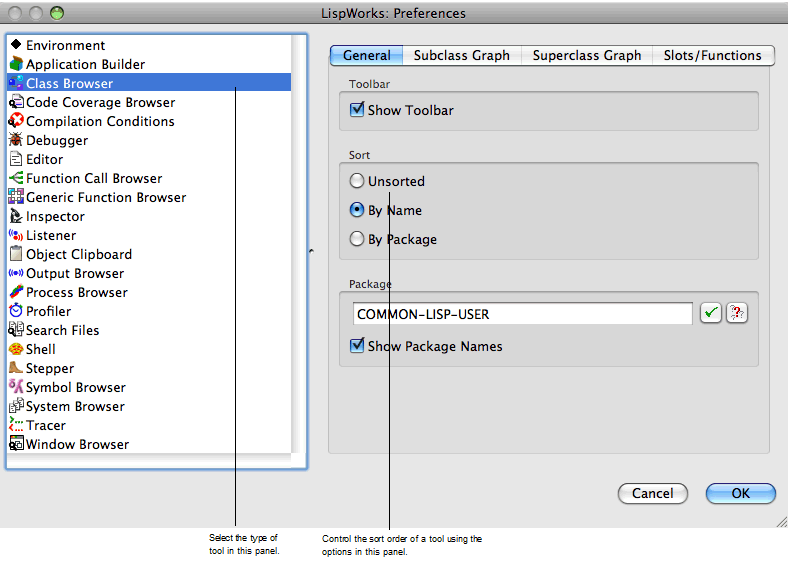






Many tools in the LispWorks IDE have several different views, each of which can display information which is pertinent to the task at hand. You can switch to any of the available views by clicking on the appropriate tab at the top of the tool. When choosing a different view, the layout of the tool itself changes.
Figure 3.7 Click tabs to display different views of a tool


In tools which are browsers, different views allow you to display different pieces of information about the same objects; for instance, in the Class Browser you can switch from a view which shows you information about the slots in a given Common Lisp class to one which shows information about the initargs of the class.
In other tools, different views may show you completely different types of related information. For example, in the Listener you can switch from the Listener view to a view that shows you any output that has been generated by the Listener.
All tools have a default view when you first start them. The default view is the one which you are most likely to make most use of, or the one which you use first. When you first start the built-in Editor, the default view is the text view. When you start a Class Browser, the default view shows you the slots available for the current class, as you have already seen.
You can sort the items displayed in the main area of any view using the Preferences for a given tool.
To specify the sorting for the Class Browser, for example:
Figure 3.8 Example General Preferences


Notice that tool Preferences, such as the one shown above, generally have several tabs. In these cases, the options described in this section are always available in the General tab, so select this tab if necessary.
The options available vary according to the tool, but at least the following will be available:
Sorts symbols in a list or graph according to the name of each item. The packages that the symbols are resident in are ignored when this option is used; thus, the symbol vv:allocate would be listed before aa:vectorize.
Sorts symbols in a list or graph according to the package they are listed in. Thus, all symbols in the aa package would be listed together, as would all symbols in the vv package. In addition, the aa package would be listed before the vv package. Within a given package, objects are listed in alphabetical order when using this option: thus, aa:carry-out-conditions would be listed before aa:vectorize.
Lists all symbols in a graph or list in the order in which they are occur naturally in the object being examined. This can sometimes be a useful option in itself, and is always the quickest option available. You may sometimes want to use this option if you are displaying a large number of items and you are not filtering those items in any way.
The option you specify takes effect when you click OK in the Preferences dialog. Your setting affects existing tools and is remembered for use when you create the same type of tool in the future.
Note: There are sometimes other options available in the Sort area of the Preferences dialog, depending on the nature of the tool. These options are described in the chapter specific to each tool.
Only those views whose main area consists of a list or a graph can be sorted. In particular, the default views of tools such as the Listener or the Editor, which is an editor window which you can type directly into, cannot be sorted.
LispWorks IDE User Guide (Macintosh version) - 12 Feb 2015